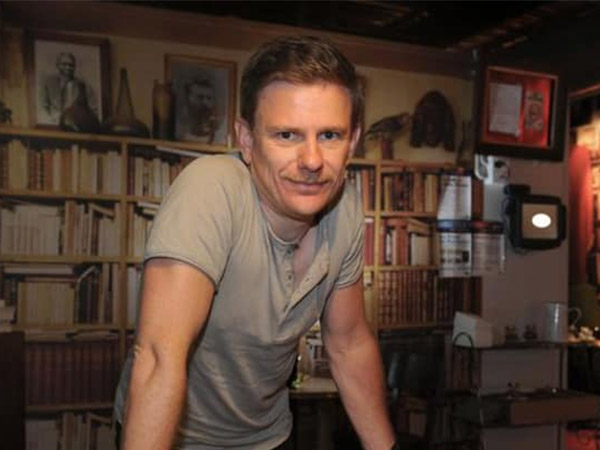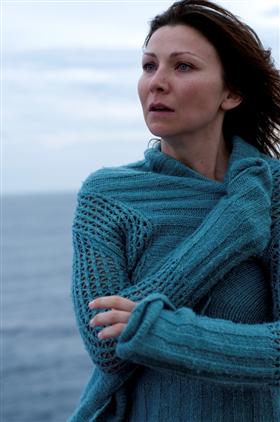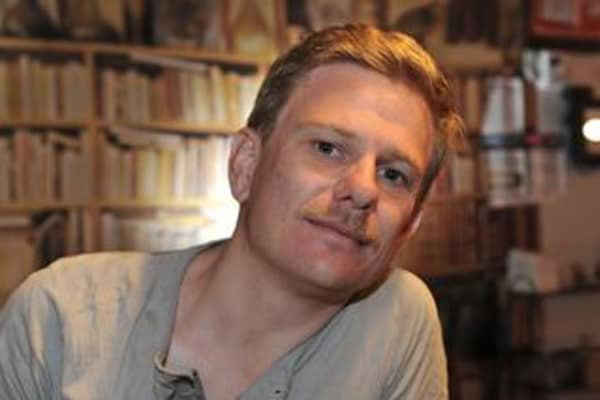
Making Art – Episode 08
Tom Holloway
Episode Released 28th October 2018
When his hauntingly moving and gently unsettling 2007 play Beyond the Neck was presented at Belvoir Street in Sydney Tom Holloway announced himself as a mid-career playwright with a powerful, distinctive Australian voice. That Beyond the Neck, which looked closely and empathetically at the lives of 4 survivors of the Port Arthur massacre, went on to receive the Australian Writers Guild Award, the AWGIE, for Best Stage Play confirmed what many good judges in the theatre world already knew, that we had an exciting voice that was deeply immersed in a sense of place and committed to telling our stories. His next work Red Sky Morning written in 2008 was awarded an R. E. Ross Trust Script Award and a Green Room Award for Best New Play. In 2010 And No More Shall We Part went one better winning both the AWGIE and also the Victorian Premier’s Literary Awards Louis Esson Prize for Drama.

Anita Hegh in Beyond the Neck
More original work has followed with productions of his plays presented here, in the US and in Europe. He has also completed the libretto for the new opera, South Pole, commissioned and premiered by the Bavarian State Opera in 2016 alongside a number of adaptions including the Australian classic Storm Boy for the STC and that terrific noir thriller Double Indemnity for the MTC.
The story of Tom’s development from teenage theatre geek to internationally recognised playwright is a compelling tale of how, amidst what is increasingly becoming a culture crisis in this country, we miraculously got something right.
Tom began acting in the mid 90’s after leaving school and came to the attention of that beautiful Tasmanian actor/director Robert Jarman. When Tom presented his first short work Jarman was there and astutely recognised Tom’s potential as a playwright. A relationship developed, an “informal mentorship” as Tom calls it which led to further support from Annette Downs who currently heads up Tasmania Performs. With a small amount of money and a lot of careful encouragement Tom progressed to the point where he was accepted into the writing course at NIDA in 2001. A number of plays resulted but it was Interplay that really “switched on the lights” and connected both he and a number of other young playwrights including Lally Katz to the rest of the world and allowed them broaden their practice by “looking internationally.”
It was contacts that Tom made at the now defunded Interplay that led to him studying at the home of the new wave of British Theatre, the place that brought us John Osborne, Harold Pinter, Sarah Kane and others, The Royal Court in 2006. Interplay was a biennial festival open to emerging playwrights aged between 18-26 years old who were considered among the best of their age in their country. Held in Townsville on the campus of James Cook University, Interplay gathered young playwrights from around the globe to meet for an intense week of mentoring, criticism and encouragement.

Forget Me Not-Presented by the Bush Theatre Shepherds Bush London
I mention Interplay because the concept was initiated here in Sydney in 1985 with Australian Government support through the Australia Council. It was part of a National Arts Policy that had at its heart an understanding of how difficult it is to develop playwrights, that paid more than lip service to role the complex ecology of the arts played in that development and had more than a passing interest in the value the exposure of these emerging storytellers to their international peers had if we were to become anything other than a net importer of stage culture. Interplay no longer exists in this country, the victim of one or another arts and culture austerity drive but the idea was adopted in Europe where a festival continues every year.
And I mention that word Policy because right at the moment at the Federal level and it must be said in most states we don’t have one. And if that wasn’t already clear then it became abundantly obvious at the recent Australia Council consultation held at the National Gallery of Victoria to discuss a review of the MPA Framework. Another day in which the performing arts community were yet again fed a little bite sized piece of what I would call “slippage”.
For those of you that don’t know, which I have rather sadly discovered includes a great many of my colleagues, the MPA Framework is the mechanism through which governments both State and Federal financially support and alternately “manage their expectations of” the 28 major performing arts organisations in this country. These include all the State Theatre Companies, Opera Australia and the Symphony Orchestras along with the others like Australian Ballet, Sydney Dance Company and key indigenous performing arts organisations like Bangarra.
The MPA’s have long had a fractious relationship with the broader creative community for a number of reasons. The principle one being that they absorb close to 65% of the total funding made available through the Australia Council. It is a sizable chunk of a decreasing pool and the very real divide between the 28 haves and the vast majority of have nots has long been a bone of contention.
In fact it was as long ago as 1981 when the Council first expressed a concern that a large percentage of its annual allocation was going to a small number of not-especially-representative companies. At the time the McLeay Report recommended a separate unit to handle the demands of this part of the sector, hoping to free up the Council’s money for the growing number of dynamic smaller arts organisations and individual artists. This recommendation arose after a rancorous redistribution debate that had created deep divisions within the creative community, a time when the chorus of “there just isn’t enough money” began. A chorus that incidentally we are all tired of uttering and yet one that continues to this day because it’s true.
Instead of separating the MPA’s both physically and financially, the Government of the day decided to leave them tied to the Australia Council and not only retained their high percentage of the total funding pool but guaranteed their funding at agreed levels effectively without having to justify their existence. They were here to stay and sadly ever since that day governments of every persuasion have slipped further back when it comes to their financial support for the arts while the majors continue untouched. It is this fact that has formed the backdrop to every major discussion with respect to Australian cultural policy to this day.
There have been a great number of reviews of Arts funding over the years, each of them an incremental trimming of financial support for all but the majors who have sailed on imperiously as the rest of the sector has been slowly strangled. But it was the $100 million in cuts imposed on the Council by the then Arts Minister George Brandis that were the metaphorical straw that broke the creative communities back. When Brandis hived off what amounted to roughly 50% of the Australia Council’s discretionary funds over four years to set up a ministerial fund in contravention of the time honoured tradition of arms-length funding for the arts and it became clear that those cuts would be exclusively borne by the smaller arts organisations and individuals, the MPA’s, for reasons best known to themselves, failed to offer any support to the sector instead remaining silent. For the rest of us it was a stunning blow. Not only had Brandis breached our trust but perhaps more importantly we had been betrayed by our colleagues in what was seen as self-serving attempt to preserve an unjustifiable inequity in the funding mix and a seething anger has persisted ever since.
So here we are staring at a review of the MPA framework, a move initiated by the Council of Cultural Ministers who must collectively think this looks like they have heard us and that they all know something about arts policy. And if Tuesday’s gathering at the NGV is anything to go by several things are clear, the Ministers have no idea, whoever is responsible for the terms of reference for the review is a nuffy and the rancorous re-distribution debate we first saw in the 1980’s is alive and well only this time the knives are out.
To be clear the Major Performing Arts Companies are in the main worse off now in real terms than they have ever been. The artistic effect of that decline in real funding is a trend on most of their parts towards a more commercial and conservative type of programming, programming that meets the expectations of their existing audiences, particularly subscriber audiences. Since these theatregoers are typically older, wealthier, ethnically homogeneous and city-based, this has added to the erosion of the social and creative legitimacy of those companies. The perception is that not only are they favoured by the funding authorities but that they in turn produce work that favours a narrow audience at the expense of the broader public. They are in one of my colleagues words “culturally unrepresentative.” And the truth is they are funded to be that way.
Do they need to change? Yes they do. At the moment they appear creatively rudderless and that is what happens when you substitute artistic intent with the imposition of key performance indicators that are beyond the scope of the organisations and removed from any connection to the reality of arts production. But let’s be clear, this is a failure not of the organisations but of policy. What needs to happen to arrest this is they must individually rediscover their artistic purpose and that artistic purpose must communicate a commitment to a genuine cultural vision. What would help here would be a government or governments that were committed to a cultural vision and not just to KPIs. And given that one of the stated objectives government has laid down for the MPA framework is a commitment to be less reliant on subsidy it actually just makes the whole exercise a bit laughable really. We have a bunch of state and federal cultural ministers doing what they always do. Not asking for better, not asking for a commitment to creative visions simply asking for more for less. And around we go again.
That government persists in having a dialogue with the sector and in particular the MPA’s that is purely focused on commercial outcomes is counter to their very which is to actively shape expectations around the art form, not just passively cater to them. They are meant to be the best we have to offer, not flabby, populist and run on the smell of an oily rag.
But what has become increasingly apparent is that the biggest problem we have is not Mitch and his dopey mates. It is advocacy. Recently at a function to launch Mark Williams Platform Paper, Falling Through the Gaps, a paper that looks at the very real damage being done to the sector at a human level I had a conversation with the former chair of the Australia Council board Rupert Myer. When I asked Rupert why the board hadn’t pushed back against the Brandis cuts under his watch he replied that if the board had responded publically it would have been inappropriate. Now Rupert is a decent man who has been a lifelong supporter of the arts but I have to say to him that that is a story he has created for himself and his board that is simply not true. The responsibility of the board of the Australia Council is to the Council, its stakeholders and the public. Not the government. The Council is a statutory authority for a number of reasons and cow towing to government is not one of them. The damage done to the sector by the board’s failure to act was a betrayal perhaps more telling than that of the MPA’s. It reinforced the belief that in the arts we are simply the shiny playthings of the wealthy, our fate in the hands of well-meaning rich men who have very little concept of the low morale of the sector, the knife edge our creatives are living on and who tinker with us like ornaments on a mantelpiece.
And that begs the question as to who is advising the board. If it is the staff of the Australia Council then on the face performance put in at the MPA forum we are in deep trouble. Lissa Twomey is the staff member of the Oz Co responsible for the MPA’s and I would have to say that her performance on Tuesday was nothing short of gob smacking and gave the impression of a person completely out of her depth, as far removed from the sector as a suburban accountant. Not only does she seem unaware of the history of the MPA framework but responded to questions with a series of what can only be described as thought bubbles befitting a first year drama student. And not a very good one at that. How we are meant to have confidence in a woman who when asked to explain how the Council thinks the MPA’s contribute to a vibrant arts ecology answers with “they employ actors” is beyond me. It was not disappointing, it was demoralising.
So what has this all got to do with Tom Holloway? Tom is one of a small group of artists who would be referred to in the theatre world as our primary producers. Actors can perform any old rubbish and we often do. But to tell Australian stories we need Australian storytellers and they require careful handling by different elements of a healthy cultural ecosystem at different stages of their career. Tom’s development was, as is the development of many a playwright, dependent on a number of factors. The coming together with an older practitioner who recognised his talent, mentored him and connected him to opportunities to grow. A number of writing programmes designed to further his understanding of the craft and small arts organisations or individuals that gave him the opportunity to learn about his writing by seeing the effect of his work in front of an audience where his words were delivered from the mouths of actors. All vital components which are either gone or disappearing at a rapidly increasing rate.

Tom Holloway
Perhaps a vibrant creative culture is “Not in the Public Interest” as Simon Birmingham said when explaining why he knocked back 11 grants to humanities scholars through the Australia research Council. Perhaps government fears that with adequate funding the arts may yet again become oppositional as they were in the 60’s, 70’s and early 80’s. There must be some reason why a government can hand over of $444 million of public money to the Great Barrier Reef Foundation when they hadn’t even asked for it, some underlying explanation as to how a Prime Minister can give more than twice the annual allocation of the Australia Council, without Parliamentary oversight, to a private foundation and yet can’t find a relatively small sum to support our arts and culture. Democracy is not just about funding what you like and listening to those who agree with you. They have a different name for that style of government.
I hope you enjoy my conversation with Tom. Relish it, because he may just be one of the last of his kind.

